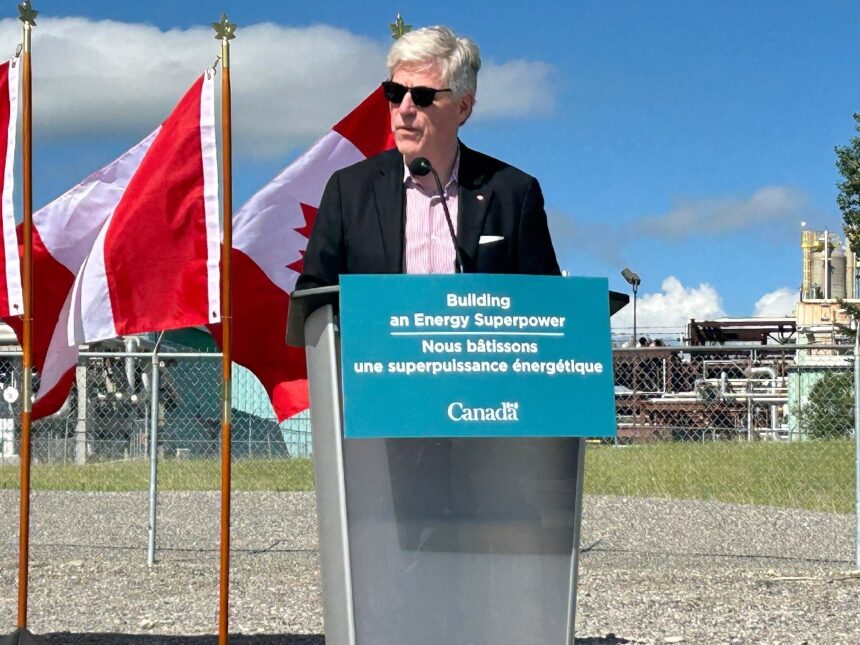Article – As Energy Minister Jonathan Wilkinson stood at the podium outside the Boundary Dam power station in Saskatchewan, the late June sun glinted off the massive carbon capture unit behind him. This facility, operational since 2014, has become both a symbol of technological promise and a cautionary tale about the complexities of climate solutions.
“Today we’re announcing an additional $2.4 billion investment in carbon capture technology across Canada,” Wilkinson declared, his voice carrying across the assembled crowd of industry representatives, workers, and a handful of environmental advocates who stood somewhat apart from the celebratory atmosphere.
I’ve visited this site three times over the years, watching as Canada’s first commercial-scale carbon capture project weathered technical challenges, cost overruns, and shifting political winds. Today’s announcement feels both familiar and freshly concerning.
The new federal investment package aims to accelerate carbon capture, utilization and storage (CCUS) deployment across Canada’s highest-emitting sectors. According to Natural Resources Canada, the funding targets the oil and gas, cement, and power generation industries with the goal of capturing 15 megatonnes of carbon dioxide annually by 2030.
“This is about protecting jobs while meeting our climate obligations,” Wilkinson emphasized, echoing almost verbatim the Canadian Association of Petroleum Producers‘ recent policy position paper from May.
This alignment between government messaging and industry talking points raises questions about who is driving Canada’s climate strategy. When I spoke with Julia Williams from Environmental Defence after the announcement, she expressed significant concerns.
“We’ve seen this pattern before. The technology remains expensive and unproven at scale, yet we’re diverting billions from proven climate solutions,” Williams told me as we walked away from the main event. “Meanwhile, the industry continues to expand production.”
The government’s announcement came just days after the Canadian Energy Regulator projected that oil production would continue growing until at least 2035, putting Canada’s emissions reduction targets in serious jeopardy according to the Climate Action Tracker consortium.
Wilkinson’s speech highlighted the potential for Canada to become a “global leader in carbon management,” but curiously avoided mentioning that the Boundary Dam project has consistently fallen short of its original carbon capture targets. Data from SaskPower’s own monitoring reports show the facility has captured only about 60% of its projected capacity since coming online.
The site’s struggles aren’t unique. The few large-scale carbon capture projects operating globally have faced similar challenges with efficiency and cost-effectiveness. A 2023 study published in Environmental Research Letters analyzed 13 commercial carbon capture facilities worldwide and found that none had met their original performance targets within the first five years of operation.
Walking through the community of Estevan later that afternoon, I stopped at a local café where conversation inevitably turned to the morning’s announcement. The economic reality here is complex – the fossil fuel industry provides stable employment in a region with few alternatives.
“We need those jobs,” said Marion Levesque, who has lived in Estevan for over 40 years and whose son works at the nearby coal mine. “But we’re not fools either. We know the world is changing, and we worry about betting everything on technology that might not deliver.”
Indigenous perspectives were noticeably absent from the day’s main event. When I reached out to Eriel Deranger, Executive Director of Indigenous Climate Action, she pointed out a troubling pattern.
“Once again, we see billions being directed toward extending the fossil fuel economy without meaningful consultation with Indigenous nations whose lands and waters will bear the impacts,” Deranger explained. “Carbon capture infrastructure, pipelines, and continued extraction all have real consequences for Indigenous communities.”
The investment announcement represents a significant portion of Canada’s climate spending. By comparison, the federal government has committed approximately $1.7 billion to renewable energy projects for the same period according to the Parliamentary Budget Office‘s climate spending analysis published this past spring.
This imbalance concerns climate policy experts like Dr. Mark Winfield of York University, who studies energy transitions. “The risk here is that we’re locking in carbon-intensive infrastructure for decades to come,” he told me during a phone interview. “Historical evidence suggests carbon capture rarely achieves promised outcomes, while renewable energy consistently exceeds cost and performance expectations.”
The numbers tell a challenging story. The International Energy Agency estimates that to align with global climate goals, Canada would need to capture over 50 megatonnes of CO2 annually by 2030 – more than three times what the current investment targets. This raises serious questions about whether carbon capture can deliver meaningful climate benefits within the timeframe scientists say is necessary.
Watching workers exit the plant at shift change, I’m reminded that this debate isn’t abstract. Real livelihoods and communities exist in these transition spaces, where climate policy meets daily economic reality. These workers deserve honest conversations about the future and support for genuine economic diversification rather than uncertain technological promises.
As I drove away from Estevan, passing oil pumpjacks nodding on the horizon, I reflected on the recurring cycle of carbon capture announcements I’ve covered over the years. Each comes with similar promises of technological salvation, yet emissions continue to rise. The journey toward meaningful climate action requires more than matching industry talking points – it demands the courage to chart a genuinely different course.
For communities across Canada – from Estevan to Fort McMurray to Kitimat – the stakes of getting this transition right couldn’t be higher.






